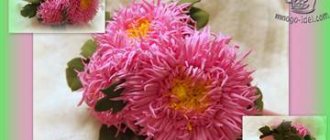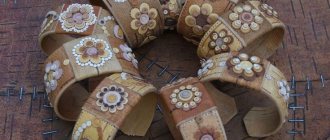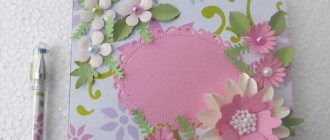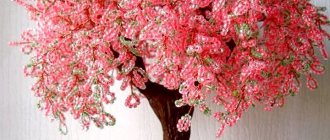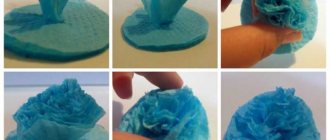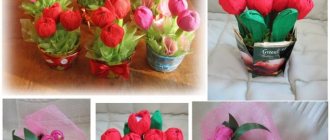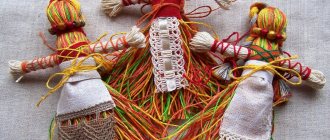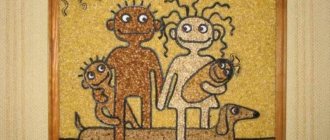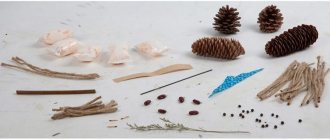Foamiran is a very pleasant material to work with. Using a simple tool and an ordinary iron, you can make beautiful flowers with your own hands. The time required to create this flower will average 2 hours. So, watch Chamomile from foamiran master class .
- Chinese foamiran 50*50 yellow sheet, thickness 1 mm;
- Chinese foamiran 50*50 white sheet, thickness 1 mm;
- Chinese foamiran 50*50 green sheet, thickness 1 mm;
- scissors;
- iron;
- lighter;
- toothpick or skewer (for squeezing out the outlines of leaves);
- glue gun;
- Super glue;
- a universal mold for applying the texture of a sheet; if you don’t have one, you can get by with a toothpick;
- ruler.
Do-it-yourself chamomile from foamiran - master class with photos | How to make a chamomile from foamiran
Foamiran is a fairly new type of material for creativity, but it can be used to create amazingly beautiful products.
For example, flowers turn out just like real ones, and with very high-quality work they cannot be distinguished from natural ones at first glance.
Today I will show you how to make chamomile from foamiran at home. And if you also decide to try yourself in this new technique, join the master class with step-by-step photos.
And from this master class you will learn how to make a rose from foamiran.
To make chamomile from foamiran we will need:
- foamiran white, yellow and green
- floral wire
- tape
- heat gun
- simple pencil
- scissors
- iron
- pastel oil paints
- wet wipes
- tweezers
- artistic knife
- curly scissors
Print or copy the template for making a daisy.
How to make a chamomile from foamiran - master class step by step with photos:
First, let's start making the flower core. Take a strip of yellow foamiran and use nail scissors to cut the fringe as thin as possible, without cutting 0.5 cm to the edge.
To make the stem, cut a wire 15-20 cm long. Bend a loop at the end of the wire.
Next, take green foamiran, apply hot glue to the edge and begin to wrap it around the wire along the entire length.
We cut out a small four-pointed star from yellow foamiran and apply a little hot glue to the center and glue it to the top of the stem where we made the loop. After applying a drop of glue to the fringed strip, we begin to roll it up. Periodically continue to apply glue to the bottom of the fringe.
- As a result, we get such a bright core.
Having rolled the fringe up to half a strip, apply glue to the lower part and glue it to the stem. Next, apply glue to the stem and continue gluing the fringe in a circle, slightly in a spiral, as indicated in the photo. Let's return to the flower itself. At the corollas we make cuts towards the center, not reaching 1 cm, thereby forming the petals of the corolla.
To make our flower look like a natural one, we need to shade it a little, because in nature there is no perfectly even color scheme. To tint the chamomile, we will take yellow and green pastels and apply them to a damp cloth.
- Using curly scissors we form the uneven edge of the petals.
We apply, shading the paint from the core of the corolla to the petals.
Using tweezers, we make veins on the petals, moving them slightly from the center of the corolla to the edge of the petals. We try to work carefully with tweezers, because... foamiran is a delicate material and can be easily cut through.
- In the center of the corolla we make a cut crosswise using an artistic knife.
- Using manicure scissors, make a jagged edge at the gluing.
- We also apply the corollas to the iron, slightly straighten each petal, giving them a beautiful shape.
- All the details of the daisy flower are ready, you can start assembling.
- We pass a stem through the center of the corolla, apply hot glue at the base of the core and glue the corolla, fixing it with our fingers.
We transfer the template of the leaves and gluing of the chamomile onto a sheet of green foamiran. We cut out the leaves and gluing with scissors, and tint the leaves with dark green pastel. For further work, we need an iron, which needs to be set to heat at medium temperature - two. Take a leaf and apply it to the iron. Before your eyes. After a few seconds, the leaf will begin to curl up at the edges - you can remove it from the iron (the longer you hold it, the more the foamiran curls under the influence of heat). While the petal is heated, stretch it along the edges with your fingers, but do not pull too hard so as not to tear it. Foamiran when stretched - stretches by 10%. Place the leaf on a rubberized mat and use a plasticine stack (not a sharp one) to make veins by lightly pressing on it. In the same way, apply the yellow core to the iron to slightly curl it. For the leaves, cut two pieces of wire and wrap it with tape. Then we glue the wire with hot glue to the leaves.
Apply glue again at the base and glue the second whisk. This is how beautiful it turns out.
- We make a small cut in the center of the gluing, carefully string it onto the stem and glue it to the flower to hide all the rough work.
- We place the leaves on the stem and secure them with tape.
Chamomile from foamiran is ready. In this way you can create a whole bouquet of daisies. You may like:
Share the article on social media. networks:
Source: https://zhenskiy-sait.ru/master-klassy-po-rukodeliju/romashka-iz-foamirana-svoimi-rukami.html
How to make a chamomile from foamiran: final assembly of the composition
The last stage of creating a chamomile is to fasten all the details into a composition: three chamomile flowers connected on one stem and complemented by leaves.
You can use special glue to glue the parts, but a glue gun is more suitable for this. It is much more convenient to use, and the composition of flowers, fastened with its help, turns out to be more accurate, without streaks and stains.
To make the finished product pleasing to the eye, it is necessary to glue all the details of the chamomile
Stages of composition assembly:
- Attaching the narrow parts of the petals to the side of the center in a circle.
- The round sepal should be used to cover the lower part of the center and the sections of the petals. To do this, you need to thread it onto the wire stem and glue it to the bottom of the flower.
- Each sheet must be folded in the middle and wrinkled to give a natural look.
- Assembling three ready-made daisies into one bush;
- Attaching leaves to the bush, sealing small defects and wire connections with them.
You can include a bud in the composition, which is made from white and green foamiran in the shape of an oval, obtained by twisting two patterns.
Chamomile from foamiran
Daisies are one of my favorite flowers, they represent purity and loyalty. I think any young girl would want to have these simple and at the same time very pretty flowers in her piggy bank. Today you will learn how you can make daisies from Thomas , and Yulia Balagurova shared a master class with us. Julia showed in detail the entire process of making these wonderful flowers.
To make chamomile we will need:
* Foamiran: yellow, white and green. * A couple of toothpicks. * Iron. * Scissors.
* Thermal gun.
Master class on making daisies from Thomas:
Take the shape of the desired color and cut it into strips. The middle will be made of yellow fom and white, cut out a piece of yellow fom approximately 1 cm wide and 7 cm long. From white fom we cut 1.2 cm wide and 9.5 cm long. For the petals we also use a white cutter, cut 3 cm wide and 30 cm long.
Now on these blanks we cut the strips only not at the very end. On the blank for the petals, we cut it in the form of a fence, and cut the middle finely. finely.
We heat the iron and apply stripes on it one by one and wait for them to fall off on their own.
We do the same with the petals.
This is roughly what you should get.
Now let's start making chamomile. We take a toothpick, drip glue onto it and begin to screw all the blanks onto it one by one. First we wind the yellow strip.
Then we continue to wind the white stripe.
Next, we take the petals and twist them, making sure that the petals in the next row lie between the petals.
We got this chamomile. Chamomile petals are sharp and need to be rounded. To do this, take nail scissors and use them to make a rounding on the petals.
- This is the bottom of our chamomile; you need to break off the toothpick or bite it off with pliers.
Now we will cut out the leaves. We cut a rectangle of 3 cm by 4.5 cm from the green fom. We make a shape similar to a leaf, then we make jagged marks on the leaves.
- We apply our finished leaf to the iron and wait for it to fall off.
- Now our leaf is ready, take a toothpick and make veins on it.
- Glue the leaves to the finished chamomile and admire the beauty.
- Thanks to the author for the master class on making chamomile from Thomas.
- Source
Pauline
professional
- Activity: 2088
- Reputation: 683
- Gender: Woman
Pauline
professional
Source: https://klubokidei.com/386637311226939906/romashka-iz-foamirana/
Foamiran chamomile with step-by-step instructions for making individual parts
After preparing templates and patterns for chamomile petals and leaves, you need to move on to adding volume to the petals and forming additional elements: centers and leaves.
Master class on creating parts:
- Applying the petals to the surface of the iron until lightly curled, it is necessary to process all the petals at once and set the iron aside.
- In the middle of each petal it is necessary to draw stripes with the sharp corner of a toothpick to give it a specific shape.
- Making the middle: cuts are made along the long edge of the strip to 2/3 of the width of the segment. After that, one of its edges is attached to the wire with the cut outward, as if rolled into a roll. To prevent unwinding, it is necessary to apply glue to the strip in random places during operation.
- After attaching the center, you need to trim it a little along the edges with scissors to add volume.
- Next, the top of the center must be held over a candle or melted with an iron to strengthen it and give it a natural look.
- Veins are drawn on the leaves using the sharp edge of a toothpick.
Step-by-step instructions for creating a chamomile from foamiran
After preparing all the necessary parts, you can begin assembling the flower.
Hairpins and elastic bands with daisies from Foma
Menu
Chamomile from foamiran is a beautiful and easy master class that will appeal to everyone who likes to make hair decorations from foamiran with their own hands. And especially for those who are just beginning their acquaintance with plastic suede. A chamomile made from foamiran can decorate a clip, a hairpin, or sit comfortably on a hair elastic. The master class is easy to repeat; it will require a minimum set of materials and very little free time.
Necessary materials
- Three types of foamiran: white for the petals, yellow for the core and green for the sepals. The minimum required to complete this master class is white; if you really want, you can paint everything else with white with oil pastels, acrylics or other paints.
- Iron for molding parts
- Manicure or any other small scissors
- Second glue or hot hot glue
- Another tricky tool, which this master class cannot do without, will have to be made with your own hands from three toothpicks: we place them in a line at the same level and glue them together with tape.
- We will also need elastic bands for hair or a base for hairpins, whichever you prefer.
- making petals,
- preparation of the core,
- flower assembly,
- attaching it with an elastic band or hairpin.
Making petals
Now let's try to add all these details to our master class.
- We begin the master class by making a template for a petal: we draw it on paper with a pencil, estimating the size of the future flower in advance.
- We unfold a sheet of white foamiran, apply the paper part to it and draw 17 such petals using a needle, knitting needle or awl. This is exactly how much it will take to make one chamomile. We cut them out with scissors.
- Turn on the iron to power 1 or 2 and, alternately applying each petal so that it warms up well, give it a beautiful bend. At this point, you can lengthen it a little by stretching it with your fingers, but not too much, otherwise it will tear.
- We take our miracle tool of three toothpicks and draw a long triple line along the front side of each petal from the base to the edge.
Flower core
From yellow foamiran we cut out a long strip 1-1.5 cm wide and an average length of 7-10 cm, depending on the desired size of the flower and the cut petals. Using scissors, finely cut the fringe from the strip, cutting it approximately to the middle in height.
We roll the strip into a roll, gluing the layers with glue so that everything holds tightly together.
Flower assembly
To make the daisy beautiful, you need to glue all 17 foamiran petals one by one to the side of the yellow roll as shown in the photo.
We glue each subsequent petal slightly overlapping the first one so that the distance between them is small.
Having completed the first row, we move on to the second, evenly gluing the white petals on top so that they fill the empty spaces between the previous ones. This is what a wonderful chamomile we get in the end.
Attaching to an elastic band or hair clip
To make an elastic band, you need to cut out a small strip of green foamiran, apply glue to it and glue it through the elastic band to the daisy.
This will give double fixation, thanks to which the product will last a long time.
A hairpin or clip is made in approximately the same way: glue is applied to a strip of foamiran or felt along the entire length and glued to the daisy through the hairpin. All is ready!
If you liked the article, share it with your friends:
Source: https://podarkiny.ru/raznoe/iz-foamirana/zakolki-i-rezinochki-s-romashkami-iz-foma.html
Video instruction
In this instruction you will be presented with a chamomile made from foamiran - a master class for beginners. The author of the video will demonstrate how to make beautiful elastic bands from chamomile petals in a short time. In addition, by gluing such a flower onto a small bobby pin or selecting special ribbons and fishing line, you can get a very stylish hairpin or wreath. Now you can use foamiran foam chamomile to make various custom-made accessories.
Dear craftswomen, did you like the foamiran daisies whose master class you saw? Did you get these flowers by following the step-by-step instructions? How long did it take you to make the flower? Would you like to make a whole bouquet by adding leaves to it?
Chamomile from foamiran "Camilla"
I got a very light and airy chamomile from foamiran .
Chamomile from foamiran
Pay attention to its petals, they are very prominent and well curved in space. I can offer you a good option for processing chamomile petals, which was born while making this hairpin.
The diameter of my flower is 8 cm. I have already made daisies using the rigid flower-making technique more than once, so I know what they should be like. Of course, you cannot apply all the tricks of hard technology to a fom, but it is quite possible to emulate it!
- Chamomile pattern. This manufacturing technology can be found in all books on domestic flower making, when we first cut out a circle, and then divide it “by eye” into 12 parts.
1 - The center can be made in different ways. We will make the middle from a strip of fom 1.5 cm high and 11-17 cm long. We cut the strip into thin strips as often as possible.
2a
We thread the leton between the strips and twist it at the base of the future middle.
2b We wind the strip around itself, gluing it as we wind it onto hot glue or a Second or Moment crystal. The middle then needs to be ruffled and trimmed. - We will need 2 petal circles with a diameter of 9 cm per daisy.
3a
Fold the circle in four, cut the quarter into three parts, unfold it and carefully form the petals with scissors.
3b Petals may differ from each other!. - We roll each petal between two fingers to give life to the material and thin it.
4 - To heat the fom over a small surface, I use a soldering iron. For convenience, you can insert a tool for flower making into it, or you can not do this, but heat it on the sting. But the soldering iron is very hot (40W) and needs to be heated very quickly. This is an analogue of processing fom on a candle, but without scorching and inhaling harmful fumes.
5 - The petal is visually divided into two parts, which is especially emphasized by the notch at the top of each petal. I first heat one part of it along the entire petal and, as it were, stretch it along the instrument. For me this is a heel, but you can also take a bubble or something similar, the main thing is that this object is smooth. 6a 6b Here in this photo I hold the tool with my right hand and pull the petal along it (the heel under the petal).
- At the bases of the petals they need to be thinned. 7a
Heat the base of the petal and gently roll it between your fingers.7b
Due to this technique, the flower turns out to be of a very interesting shape. In the very center of the corollas, make a small depression so that all the petals rise slightly upward.
So it turns out like this:
Source: https://vortexflowers.net/master-klassy/romashka-iz-foamirana-kamilla/
DIY daisies from foamiran
DIY foamiran daisies can be used in a head decoration (wreath, hairpins, elastic bands), flower arrangement, and also as a brooch or an independent flower.
Materials and tools
| foamiran yellow and white | pastel, wet wipes |
| tape tape | glue for foam and glue gun |
| scissors | iron |
| floral wire | stack |
How to make daisies from foamiran with your own hands? Step-by-step instructions for children and adults
From yellow foamiran we cut out a strip 1 cm wide and 8 cm long.
Using scissors, we cut the strip into a narrow fringe, not reaching the edge of the strip by about 3 millimeters.
We heat the workpiece on the iron in several stages, in small sections
While the fom is hot, bend the cloves inward
We twist the workpiece in a spiral, fixing the turns with glue and forming a round center of the chamomile. We twist the middle onto floral wire No. 26, 28
- The chamomile core is ready. Let's move on to the petals
- We translate a template from a book or copy it from the Internet, or we draw it ourselves.
- We cut out two parts for a daisy flower from white faux paper
- We tint the central part of the chamomile with a light green pastel.
- We wrap a damp napkin around the index finger, apply pastel on it and tint the petals in the central part
- To create texture on the petals you will need a mold, and since we don’t have a mold, we decided to use a stack.
- We heat each petal with an iron and draw it with a stack, making longitudinal veins
- We collect chamomile.
- Drop a drop of second glue into the center of one of the flower blanks and press the yellow center.
- Apply a little glue to the white blank around the chamomile core and press the petals so that some of them look up and away.
- Glue the second piece from below and form a daisy.
- Chamomile is ready.
- You can glue a hairpin to the daisy.
If daisies go into a bouquet, then we wrap the wire with tape. We form a bouquet of daisies.
DIY foamiran daisies are ready!
04/15/2017 498
Source: https://21vu.ru/mk/33278-romashka-iz-foamirana-svoimi-rukami
Foamiran chamomile: templates and their production
The first step in making a chamomile or any other flower from plastic suede is making a template, which will subsequently be transferred to the material to create petals, leaves and other elements of the composition.
You can draw templates for making chamomile yourself or print ready-made ones from the Internet.
You can prepare templates for future chamomile from foamiran yourself
The process of making templates for chamomile:
- Draw a daisy petal on the cardboard. Its width should be about 1 cm and height -3 cm;
- Draw on cardboard a leaf with teeth, like a real chamomile, 2 cm wide and 6 cm high;
- Cut out the templates with scissors.
The example shows average sizes. In practice, you can make them in any way, but it is advisable not to use templates that are too small, since working with foamiran parts in such sizes is not entirely convenient.
Do-it-yourself chamomile from foamiran: 6 ways to make it
Chamomile made from foamiran looks very elegant and relaxed Foamiran is a unique material that has a plastic structure. It is very popular in the manufacture of jewelry, decorative items and holiday accessories. A huge range of colors allows you to use foamiran for sculpting a variety of colors, which turn out to be as realistic as possible and amazingly beautiful. Chamomile made from foamiran has one of the simplest and most accessible manufacturing techniques for beginners, not inferior to other flower models in delicacy and originality.
Chamomile from foamiran: master class on choosing the main material
Foamiran recently began to be used in our country for handicrafts.
Thanks to its elasticity and ease of working with it, this material has in a short time gained great popularity among needlewomen and lovers of original handmade decorative elements.
The presence of a wide range of colors of the material allows you to create jewelry, toys and even entire compositions that amaze the imagination with their realism. Very often, foamiran is called plastic suede due to its flexibility in work.
Foamiran is a material produced in thin sheets that are pleasant to the touch and have a slightly porous structure. It is made from foam rubber and has the following properties:
- Water-repellent properties;
- Ability to take the desired shape when heated;
- Ability to keep fit;
- Not affected by heat or frost.
To create a daisy from foamiran, choose high-quality material
The stores offer foamiran made in China and Iran. The latter is considered to be of higher quality, as it is thinner than the Chinese one.
Therefore, to make flowers, it is better to take plastic suede made in Iran, because the work made from it is more elegant and realistic.
If necessary, individual parts of the composition can be tinted with powder or paints to give the product a certain shade.
By heating foamiran, you can obtain parts of a certain shape or volume. Most often, a candle or iron is used for this.
When opening a roll of plastic suede, you can feel a specific smell, but this cannot be called a disadvantage, since it will disappear over time. The thickness of the foamiran sheet is about 1 mm. On sale, this material is presented in individual sheets of a certain color or in a set of 20-24 pieces in an assortment.
DIY chamomile from foamiran: tools and materials for creating a flower
Chamomile is a symbol of purity and family, so this flower is very popular as decoration at weddings and theme parties. It will add tenderness and sophistication to any interior as a decorative element. The use of artificial daisies in the design of a room will help preserve the atmosphere of spring and comfort for a long time in a building of any type.
The technique of sculpting flowers from foamiran itself is quite easy, but you should be careful and careful while working. For beginners, it is better to use the step-by-step guide for creating a daisy from this material.
The technique for making chamomile from foamiran is quite simple.
To create a chamomile from foamiran you will need:
- Foamiran is white;
- Foamiran green and yellow;
- Cardboard;
- Scissors;
- Floral wire for stem;
- Simple pencil;
- Glue gun;
- Iron;
- Tweezers;
- Toothpick.
Having prepared the above materials and tools, you can begin to create a chamomile from foamiran.
Foamiran chamomile: templates and their production
The first step in making a chamomile or any other flower from plastic suede is making a template, which will subsequently be transferred to the material to create petals, leaves and other elements of the composition.
You can draw templates for making chamomile yourself or print ready-made ones from the Internet.
You can prepare templates for future chamomile from foamiran yourself
The process of making templates for chamomile:
- Draw a daisy petal on the cardboard. Its width should be about 1 cm and height -3 cm;
- Draw on cardboard a leaf with teeth, like a real chamomile, 2 cm wide and 6 cm high;
- Cut out the templates with scissors.
The example shows average sizes. In practice, you can make them in any way, but it is advisable not to use templates that are too small, since working with foamiran parts in such sizes is not entirely convenient.
How to make a chamomile pattern from foamiran
The process of transferring the design onto foamiran followed by cutting is very easy. To do this, you need to attach the template to the material and cut out the parts along the contours. You can also transfer the drawing with a pencil onto the material and carefully cut it along the line. The pattern is ready.
The petals should be even and approximately the same size. And the leaves can be made in different sizes by first cutting out the templates.
For a composition of three daisies you need to prepare:
- Petals - 11 pcs.;
- For the middle - 3 strips of yellow foamiran measuring 0.5 cm x 14 cm;
- Green foamiran leaves - 5 pcs.;
- Sepals (under the base of the flower) - 3 pcs.
The number of flowers and details for them can be selected arbitrarily in accordance with the wishes of the artist.
Foamiran chamomile with step-by-step instructions for making individual parts
After preparing templates and patterns for chamomile petals and leaves, you need to move on to adding volume to the petals and forming additional elements: centers and leaves.
Master class on creating parts:
- Applying the petals to the surface of the iron until lightly curled, it is necessary to process all the petals at once and set the iron aside.
- In the middle of each petal it is necessary to draw stripes with the sharp corner of a toothpick to give it a specific shape.
- Making the middle: cuts are made along the long edge of the strip to 2/3 of the width of the segment. After that, one of its edges is attached to the wire with the cut outward, as if rolled into a roll. To prevent unwinding, it is necessary to apply glue to the strip in random places during operation.
- After attaching the center, you need to trim it a little along the edges with scissors to add volume.
- Next, the top of the center must be held over a candle or melted with an iron to strengthen it and give it a natural look.
- Veins are drawn on the leaves using the sharp edge of a toothpick.
Step-by-step instructions for creating a chamomile from foamiran
After preparing all the necessary parts, you can begin assembling the flower.
How to make a chamomile from foamiran: final assembly of the composition
The last stage of creating a chamomile is to fasten all the details into a composition: three chamomile flowers connected on one stem and complemented by leaves.
You can use special glue to glue the parts, but a glue gun is more suitable for this. It is much more convenient to use, and the composition of flowers, fastened with its help, turns out to be more accurate, without streaks and stains.
To make the finished product pleasing to the eye, it is necessary to glue all the details of the chamomile
Stages of composition assembly:
- Attaching the narrow parts of the petals to the side of the center in a circle.
- The round sepal should be used to cover the lower part of the center and the sections of the petals. To do this, you need to thread it onto the wire stem and glue it to the bottom of the flower.
- Each sheet must be folded in the middle and wrinkled to give a natural look.
- Assembling three ready-made daisies into one bush;
- Attaching leaves to the bush, sealing small defects and wire connections with them.
You can include a bud in the composition, which is made from white and green foamiran in the shape of an oval, obtained by twisting two patterns.
Beautiful chamomile from foamiran: master class (video)
A bouquet of daisies will be ideally complemented by cornflowers made from foamiran. This color combination, or a combination of colors modified at your discretion, can be used to decorate a living space, a formal hall or an office. A hairpin or wreath with a chamomile made from foamiran will look gorgeous.
Flowers made from this material are often decorated with elastic bands, brooches, bags or belts. With the help of handmade daisies, you can bring many design ideas to life.
The presence of a composition of daisies in the house will have a beneficial effect on people’s mood and the atmosphere of the home as a whole.
How to make chamomile from foamiran (photo of options)
Source: https://kitchenremont.ru/dekor/hand-made/romashka-iz-foamirana
Chamomile from foamiran: master class on choosing the main material
Foamiran recently began to be used in our country for handicrafts. Thanks to its elasticity and ease of working with it, this material has in a short time gained great popularity among needlewomen and lovers of original handmade decorative elements. The presence of a wide range of colors of the material allows you to create jewelry, toys and even entire compositions that amaze the imagination with their realism. Very often, foamiran is called plastic suede due to its flexibility in work.
Foamiran is a material produced in thin sheets that are pleasant to the touch and have a slightly porous structure. It is made from foam rubber and has the following properties:
- Water-repellent properties;
- Ability to take the desired shape when heated;
- Ability to keep fit;
- Not affected by heat or frost.
To create a daisy from foamiran, choose high-quality material
The stores offer foamiran made in China and Iran. The latter is considered to be of higher quality, as it is thinner than the Chinese one. Therefore, to make flowers, it is better to take plastic suede made in Iran, because the work made from it is more elegant and realistic. If necessary, individual parts of the composition can be tinted with powder or paints to give the product a certain shade.
By heating foamiran, you can obtain parts of a certain shape or volume. Most often, a candle or iron is used for this.
When opening a roll of plastic suede, you can feel a specific smell, but this cannot be called a disadvantage, since it will disappear over time. The thickness of the foamiran sheet is about 1 mm. On sale, this material is presented in individual sheets of a certain color or in a set of 20-24 pieces in an assortment.
Master class: Cape chamomile from foamiran
I would like to introduce you to a very unusual flower, osteospermum, also known as Cape chamomile or Cape daisy. Osteospermum looks like the familiar chamomile, but there are some species whose petals are rolled into tubes, which makes it mysterious and unusual. At the same time, the flowers are brightly colored, with many colors.
The diameter of the center should be no more than 2 cm. To form the pattern of the center, we will prepare three strips of light purple, dark purple and yellow foamiran.
The width of all stripes is the same - 1 cm, but the length is different: the two purple stripes have 15 cm, the length of the yellow stripe is 10 cm.
We cut all the strips with a very thin “fringe”, without cutting a few millimeters to the opposite edge.
Now take the floral wire of the required length and make a loop at the end. We will first glue a dark purple “fringe” around this wire (the dark purple “fringe” should be no more than 0.5 cm in diameter).
Next we glue the light purple “fringe”, and we begin to glue it a few millimeters lower than the previous one. In the structure of the picture, the light purple “fringe” should be 0.5-0.7 cm. Next, glue 2-3 turns of the dark purple “fringe” and 1 turn of the yellow one. As a result, the diameter of the center is no more than 2 cm.
Now here's a little trick. We take sharp scissors and cut off a few millimeters at an angle to the center of the middle. If you don’t like the result, then level it again so that you get a small “mound” in the center of the middle, and then it smoothly goes down, as in the photo. The middle is ready.
Making petals
Using the templates, cut out the petals (No. 1) from light purple foamiran and the sepals (No. 2) with leaves (No. 3) from green.
Template dimensions: size of one petal in the petal circle (No. 1) - height 4.5 cm, width 1 cm, at the widest point; sepal (No. 2) 3.5 cm in diameter; The leaves can be any size (I made two larger and two smaller).
For one flower you will need: 2 pieces each - parts No. 1, 1 piece - No. 2 and No. 3 - any quantity as desired (I have 2 larger and 2 smaller).
Now we tint our blanks. Moreover, we will tint each side of the petal circle with different colors. For the front side, mix 2 colors: carmine and purple. For the reverse side - purple and blue. You can replace it with other colors, for example, burgundy or dark red on the front side, and dark lilac on the back side.
Then take a piece of sponge, dip it in paint, blot the excess onto the paper and, using rubbing movements, tint all the petals. First, one color on the front side, then another on the back. When tinting, we try to hold the petals at the base so as not to tear them off.
We tint the leaves and sepals as desired (darker green).
Let's start processing the petals and leaves with sepals. Apply the petal circle to the iron for a few seconds, then quickly gather it into a ball and rub it between your palms.
Carefully straighten each petal so as not to tear.
We also heat the leaves on the iron for a few seconds and apply them to the mold until they have cooled down. Thereby giving texture to the leaves. Then we pull the edges of the leaves a little, giving them liveliness. We also heat the sepals on an iron, collect them in a “bun” and rub the edges between our fingers.
Now let’s give the petals that unusual shape that makes them different from a chamomile. We twist each petal into a small tube, departing 0.4-0.5 cm from the edge of the petal, as in the photo.
The front side turned out to be more red, the back side more purple. We twist the petals to the front side.
The edges will curl a little, and now quickly apply a drop of second glue to the edge and twist again (carefully, take care of your fingers))). Let's do this with all the petals.
How to make a chamomile pattern from foamiran
The process of transferring the design onto foamiran followed by cutting is very easy. To do this, you need to attach the template to the material and cut out the parts along the contours. You can also transfer the drawing with a pencil onto the material and carefully cut it along the line. The pattern is ready.
The petals should be even and approximately the same size. And the leaves can be made in different sizes by first cutting out the templates.
Patterns of chamomile parts
For a composition of three daisies you need to prepare:
- Petals - 11 pcs.;
- For the middle - 3 strips of yellow foamiran measuring 0.5 cm x 14 cm;
- Green foamiran leaves - 5 pcs.;
- Sepals (under the base of the flower) - 3 pcs.
The number of flowers and details for them can be selected arbitrarily in accordance with the wishes of the artist.
